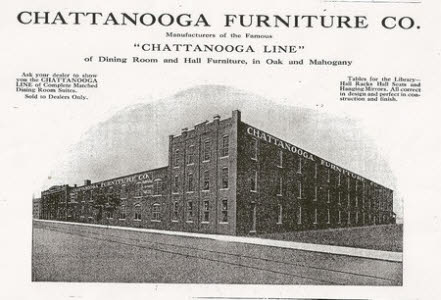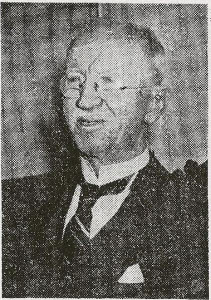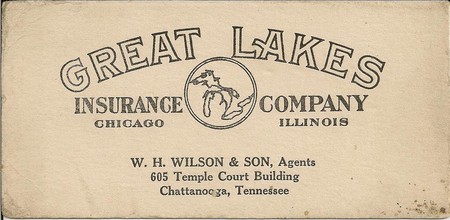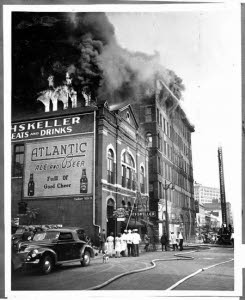
Temple Court Building was located at 622-626 Cherry Street and 101-105 East Seventh Street. Click to enlarge.

Capt. Henry F. Temple

Chattanooga Furniture Company was located on Chestnut Street.

Judge W.B. Swaney

Provident office photo showing Thomas Maclellan (beard) and Robert J. Maclellan (far right)

Great Lakes Insurance Company was represented by W.H. Wilson locally.

Fire in 1947 destroyed the top floor of the Temple Building.
In the fall of 1892, a new office building was rising on the northeast corner of Seventh and Cherry streets in downtown Chattanooga.
Only thirty years earlier, Civil War photographs of Chattanooga captured images that resembled a frontier town of the American West. Now, the city was ready for a building to serve new businesses, as well as the law firms associated with Chattanooga’s relatively new role as the seat of Hamilton County government. The time was right for the Temple Court Building to be opened.
The Chattanooga Times reported on October 17, 1892 that the Temple Court Building was under construction. It was a multi-story block structure. The first floor was brown sandstone, and the upper floors were covered in red pressed brick.
The “Court” part of the name was due to the structure’s proximity to the Hamilton County Court House. Within a few years of its opening, the Temple Court became the address of numerous lawyers, many of whom made the short walk, one block up Walnut Hill, to the courts building.
The “Temple” portion was likely connected to Capt. Henry Frederic Temple and his family, who had offices for their Chattanooga Furniture Company there. For the first few years, the manufacturer was the only occupant.
Henry F. Temple was born in 1840 in Utica, New York. His father, a native of Germany who came to the United States in 1815, was involved in manufacturing. Henry eventually carried on the family tradition, though service in the Civil War interrupted his plans.
Capt. Temple fought in the battle of Chickamauga, and may have taken note of the area’s rich resources while here.. After the war, he returned to Illinois, and joined the family’s manufacturing operation. After the Chicago fire of 1871 destroyed the family’s factory, he returned to the Chattanooga area as an entrepreneur in 1874.
The Southern Pump & Pipe Company was Capt. Temple’s first business in the city, followed by the Chattanooga Furniture Company. In 1893, he was one of five men who built the first Incline Railway up Lookout Mountain. Capt. Temple also served without pay as Chattanooga mayor in 1880.
At some point, the interest in the Temple Court Building passed to Judge William Bentley Swaney, a prominent attorney and dean of the Chattanooga College of Law. He also served as an associate justice of the Tennessee Supreme Court.
In addition to law offices, the Temple Court Building also housed insurance agencies. Provident Life and Accident had space there in its early years. The Wallace H. Wilson Company sold insurance and real estate.
On May 17, 1947, the Chattanooga Times reported that a 3-alarm fire destroyed the attic and most of the roof of the Temple Court Building. The afternoon blaze started in the office of a pencil company, and drew a large crowd of spectators. The fire department deployed an eighty-five foot aerial truck to extinguish the flames.
News coverage also included commentary on what was going on around the building, such as an oblivious driver sleeping in his taxi cab outside the Park Hotel on Seventh Street. Customers of the nearby Rathskeller restaurant were evacuated.
A renovation project commenced over the next several months. The fire-damaged top floor of the building was removed, and a sprinkler system was installed. New wiring, plumbing, and trim were installed.
When the building re-opened in August, 1948, it was given a new name – the Jackson Building, a name whose origin I could not find.
The 1966 city directory listing for the Jackson showed far fewer attorneys and a more diverse set of businesses. Alcoholics Anonymous, Capital Finance, the Chattanooga Boys Choir, and several physicians had offices there.
In “Big Yellow Taxi” by Joni Mitchell, “they paved paradise and put up a parking lot.” In Chattanooga, they often tore down historic buildings and put up parking lots and garages. Such was the fate of the Temple Court Building / Jackson Building.
In the mid-1970’s, Hamilton County replaced its jail with a new Justice Building. In 1976, the Jackson Building was felled in favor of a parking garage for the Justice Building.. The April 20, 1976 Chattanooga Times depicted the demolition.
If you have memories of the Temple Court / Jackson Building, or know about the renaming of the structure, please send me an email at jolleyh@bellsouth.net.